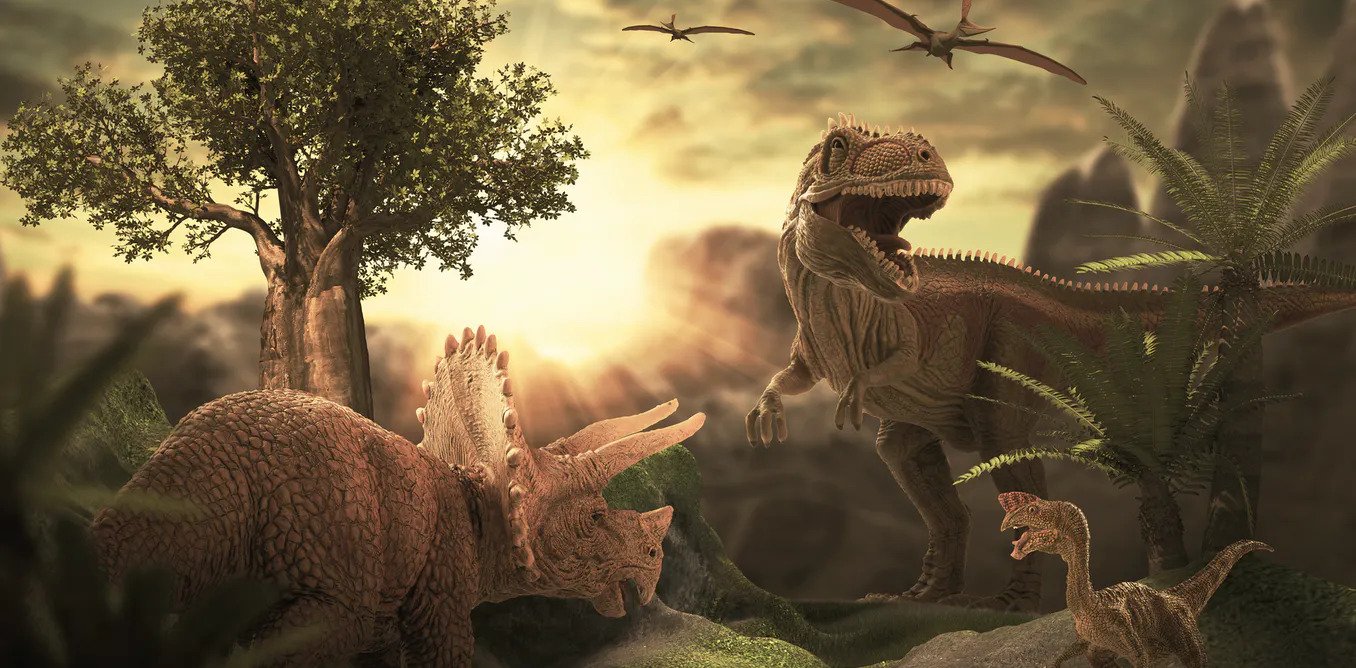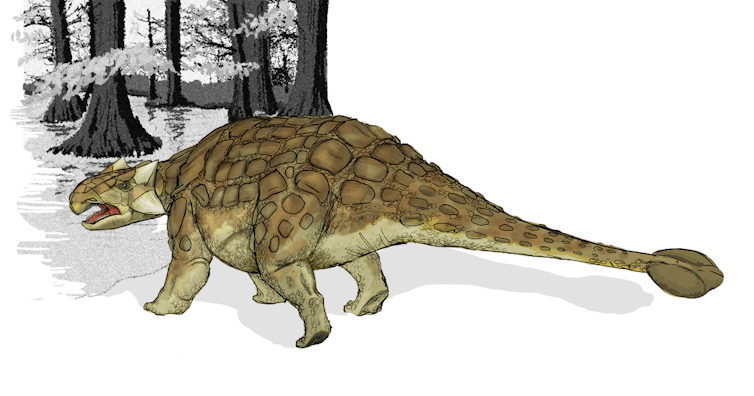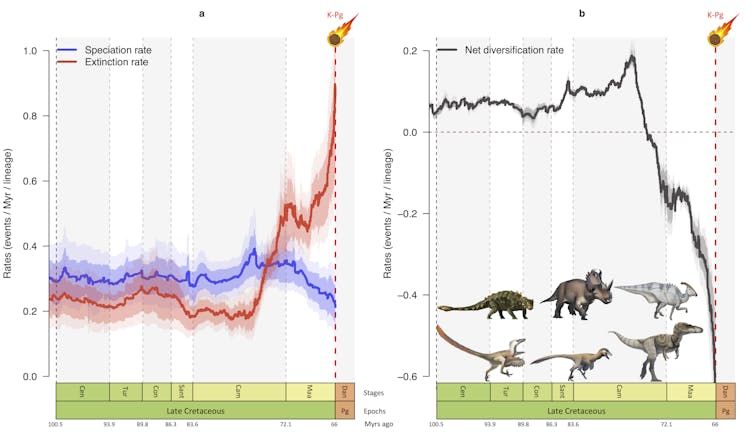 Life was already getting harder for dinosaurs before an asteroid wiped them out. metha1819/Shutterstock
Life was already getting harder for dinosaurs before an asteroid wiped them out. metha1819/ShutterstockSome 66 million years ago, on the Yucatán peninsula in México, a 12 kilometre-wide asteroid crashes to Earth. The impact causes an explosion whose magnitude is hard to imagine today – several billion times more powerful than the atomic bomb dropped on Hiroshima.
Most of the animals on the American continent are killed immediately. The impact also triggers worldwide tsunamis. Tons and tons of dust are ejected into the atmosphere, plunging the planet into darkness. This “nuclear winter” causes the extinction of many plant and animal species.
Among the latter, the most emblematic: the dinosaurs. But how were the dinosaurs faring before this cataclysm? This is the question we try to answer in our new study, the results of which have just been published in the scientific journal Nature Communications.
We were interested in six families of dinosaurs, the most representative and the most diversified of the 40 million years that preceded the arrival of the asteroid.
Three of these families were carnivorous: the Tyrannosauridae, the Dromaeosauridae (including the famous velociraptors, made famous by the Jurassic Park movies) and the Troodontidae (small dinosaurs similar to birds).
The other three were herbivores: the Ceratopsidae (represented in particular by the Triceratops), the Hadrosauridae (the richest of all the families in terms of diversity) and the Ankylosauridae (represented in particular by the ankylosaur, a dinosaur covered in bony armour with a club-like tail).
We knew that all these families had survived until the end of the Cretaceous marked by the fall of the asteroid. Our goal was to determine at what rate these families diversified – formed new species – or became extinct.

–
For five years, we compiled all the known information on these families in order to try to work out how many of them there were on Earth at a particular time, and which species were in each group. In palaeontology, each fossil is given a unique number for the sake of traceability, which allows us to follow it through the scientific literature over time.
The work was tedious – we inventoried most of the known fossils for these six families, which represented more than 1,600 individuals from around 250 species. It’s not easy to properly categorize each of the species and date them correctly: one researcher might have given a record a certain date and species, and then another might re-examine it and make a different analysis. In these cases, we had to make our own calls – if we had too many doubts, we eliminated the fossil from the study.
Once each fossil was properly categorized, we used a statistical model to estimate the number of species that evolved over time for each family. We were thus able to trace the species that appeared and disappeared between 160 and 66 million years ago and estimate, again for each family, the rates of speciation – the evolution of new species – and extinction over time.
To estimate these rates, we had to take several confounding factors into account. The fossil record is biased: it is uneven in time and space, and some types of dinosaur simply do not fossilize as well as others. This is a well-known problem in palaeontology when estimating the dynamics of past diversity.
Sophisticated models can account for uneven preservation over time and between species. In doing so, the fossil record becomes more reliable for estimating the number of species at any given time. But it is important to be cautious, because we are talking about estimates, and these estimates may change if we find more fossils, for example, or new analytical models.
A steep decline
Our results show that the number of species was in steep decline from 10 million years before the asteroid strike until the dinosaurs were wiped out. This decline is particularly interesting because it is worldwide, and affects both carnivorous groups such as tyrannosaurs, and herbivorous groups such as triceratops.
Some species declined sharply, like the ankylosaurs and ceratopsians, and only one family out of the six – the troodontids – shows a very small decline, which took place in the last five million years of dinosaurs’ existence.

–
What could have caused this strong decline? One theory is climate change: at that time, the Earth underwent a period of global cooling of 7 to 8°C.
We know that dinosaurs need a warm climate for their metabolism to function properly. As we often hear, they were not ectothermic (cold-blooded) animals like crocodiles or lizards, nor endothermic (warm-blooded), like mammals or birds. They were mesotherms, a metabolic system between reptiles and mammals and needed a warm climate to maintain their temperature and thus perform basic biological functions. This temperature decrease must have had a very strong impact on them.
It should be noted that we found a staggered decline between herbivores and carnivores: the grass-eaters declined slightly before the meat-eaters. It’s probable that the decline of herbivores caused the decline of carnivores. This is what we call cascade extinction.
The knockout blow
One big question remains: what would have happened if the asteroid had not crashed? Would dinosaurs have gone extinct anyway, due to the decline that had already begun, or could they have rebounded?
It’s very difficult to say. Many palaeontologists believe that if the dinosaurs had survived, primates and therefore humans would never have appeared on Earth.
An important fact is that a possible rebound in diversity can be very heterogeneous and group-dependent, so that some groups would have survived and others not. Hadrosaurs, or “duck-billed” dinosaurs, for example, showed some form of resilience to the decline and might have bounced back after the decline.
What we can say is that the ecosystems at the end of the Cretaceous period were under significant pressure due to climatic deterioration and major changes in vegetation, and that the asteroid dealt the final blow.
This is often the case in the disappearance of species: first they are in decline and under pressure, then another event intervenes and finishes off a group that may have been on the verge of extinction anyway.
Want to write?
Write an article and join a growing community of more than 129,700 academics and researchers from 4,085 institutions.









